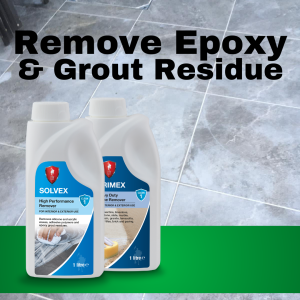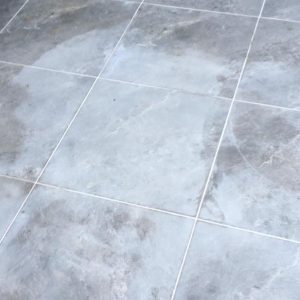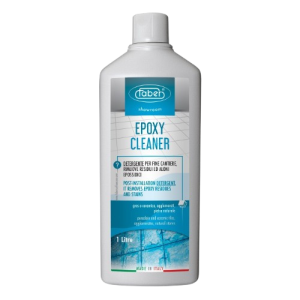We use cookies to ensure that we give you the best experience on our website. If you continue to use this site we will assume that you are happy with it. Learn more
How to Remove Epoxy Residues & Grout from Stone Tiles
How to Remove Epoxy Residues & Grout from Old Tiles

In this article, I will take you through a step-by-step guide on how to remove epoxy grout, sealer and wax from previously installed stone surfaces. This method makes use of specialised solutions to achieve unique results whether you’re a professional or a beginner.
During the stone tile installation process, installers use pre-mixed brush-in resin grouts. While these do offer heightened bond strength and resistance to water and staining, they also come with disadvantages. These resin grouts are difficult to work with and easily stain tiles.
This wax and epoxy grout residue removing method gets rid of these stains to restore your great-looking stone tiles.
For the best hard floor restoration and protection equipment and methods, visit the Tiling Logistics blog. Each article on our blog is written by an experienced member of our team to explain the best tools for you and guide you through using them.
To speak to our experts directly, give us a call at 0121 773 9129 or send us a message online.
What are Epoxy Residues?
Epoxy is known as a strong, heavy-duty adhesive. Epoxy adhesives bind resins together. These resins are capable of absorbing mechanical and thermal stress thus granting them durability, stiffness and heat resistance.
As a result, epoxy resins are useable for a range of surface treatments such as: installation, grouting and sealing.
Why clean epoxy residues?
Despite the many uses and benefits of epoxy resins, the incorrect application can do more damage than good and the appearance of your surfaces suffer.
Expoxy resins take up to 24 hours to completely dry and cure so you must act quickly after the wrong application. However, to avoid further damage to surfaces, the correct epoxy remover is a must.
How to clean epoxy residues and grout -
1. Apply LTP Solvex
LTP Solvex is a top-efficiency stripper solution that works to remove epoxy grout, surface sealer and wax. It also effectively softens up a number of substances and residues for easy removal.
Effective against:
- Epoxy grout residues
- Wax
- Oil
- Silicone, Acrylic and Polyurethane Sealers
Pour LTP Solvex into a glass or metal container when applying the residue remover to your surfaces. Do not do this with a plastic container.
Now, apply the epoxy remover to the surface by dabbing with a cloth or brush. Be sure to work in manageable areas, no more than 5 square meters.
Wen used to remove residues from epoxy grout, be sure to prevent prolonged contact with the joint.
If removing residues from epoxy grout; apply making sure to avoid prolonged contact with the joint as well.
2. Let the solution work
After application, leave LTP Solvex to work on the surface for up to 30 minutes.
In this time, the solution must not dry out. Add more if it begins to dry.
3. Remove the residues
By now, residues and coatings should be softened or gone completely. Get rid of any remaining softened coatings with a scrub brush or abrasive pad.
The use of a scrub brush or abrasive pad manually removes the residues that LTP Solvex has softened up.
Repeat the previous steps if necessary.
4. Rinse with LTP Grimex
As the name implies, LTP Grimex is heavy-duty grime and stain remover. It works on both artificial and natural stone floors.
It is effective against:
- Oil
- Grease
- Ingrained dirt
- Grime
- Old wax layers
- Surface sealers
Dilute LTP Grimex with warm water in a 1:3 ratio.
Apply the diluted solution with to the floor with a mop.
5. Wipe away the solution
Rinse the surface with plenty of clean water. Then, use a damp cloth to wipe away the diluted Grimex solution and any remaining waste.
Now you're ready
Now you know how to remove wax and epoxy grout residue from old stone surfaces.
It’s time to start stripping and cleaning your own stone tiles.
Learn More
If you want more information on anything said about the epoxy resin removal process don’t hesitate to reach out.
The team here at Tiling Logistics are always more than happy to answer any questions. For the answer to any questions you have, give us a call at 0121 773 9129 or send us an online message.
Also, remember to visit our blog for any other floor restoration or protection treatments you need.
Why Tiling Logistics?
The team at Tiling Logistics have a great passion for surface care, to the point where members of our team have spent over 15 years in this industry. Above all else, this 15 years worth of up-close experience has granted us a great understanding of stone and tile surface care.
We have come to understand the best tools, products and methods for any surface care treatment. As a result, we are sure to have the best advice for you whether you are working on a domestic, commercial or industrial property.
Alternative Method for removing epoxy and grout
What will you need?
To clean epoxy resin with Faber Epoxy Cleaner, you will need a cloth and a mop. You also need a single-disc machine or a large brush.
Why Faber Epoxy Cleaner?
Faber Epoxy Cleaner is an alkaline-based cleaner.
As the name suggests, this epoxy cleaner is excellent for removing long-standing epoxy residues.
Thanks to its unique formula, this residue cleaner is also very effective for removing film or stains. Film and stains left behind when recently installed surfaces aren’t properly cleaned, if at all.
Additionally, this epoxy residue cleaner is especially effective when removing synthetic residues, including the most stubborn and persistent residues.
This includes:
- Graffiti
- Pain
- Enamels
What surfaces are suitable for Faber Epoxy Cleaner?
Faber Epoxy Cleaner is ready for use on a wide variety of materials.
Suitable for Use On:
- Basaltina - lava stone
- Cementina
- Clinker
- Concrete
- Cotto
- Glazed ceramics
- Granite
- Lapped porcelain stoneware
- Limestone
- Marble
- Marble-cement agglomerate
- Marble-resin agglomerate
- Marble-quartz agglomerate
- Molten basalt
- Natural porcelain stoneware
- Polished porcelain stoneware
- Porphyry
- Quarzite
- Reconstituted stone (Eco Stone)
- Sandstone
- Slate
- Terracotta
- Textured porcelain stoneware
- Travertine
- Tuff
Moreover, as an alkaline cleaner, Faber Epoxy Cleaner is suitable for acid-sensitive surfaces.
It is a fast-acting detergent that easily cleans the most stubborn of stains and residues on hard to clean materials. In fact, even low-thickness materials or materials with a micro-textured surface finish are suitable for Epoxy Cleaner.
Furthermore, its mild yet powerful formula doesn’t cause corrosion or aggression. Due to this, this stain remover won’t alter the appearance of surfaces.
How to clean epoxy resin
1. Ensure surfaces are clean
Before the treatment, clean away any dry residues including coarse dirt, debris and dirt. Do this with a vacuum cleaner or broom.
2. Apply Faber Epoxy Cleaner to the surface
Firstly, apply the undiluted stain remover to the surface, completely covering the entire area. Then, evenly disperse the solution with a large brush or single-disc machine.
3. Leave time for the product to work
Afterwards, allow time for the epoxy cleaner to act.
Allow time:
- For soft residues - wait 10 - 15 minutes
- For stubborn or aged residues - wait 20 - 30 minutes
Whilst waiting, regularly pass over the area with a single-disc machine or large brush in order to help Epoxy Cleaner’s dissolving action. Doing this also improves the end results of this treatment.
What is more, when treating absorbent surfaces, we advise applying more of the product to the surface. Thus, compensating for what has already been absorbed. For optimum results, a fine layer of the epoxy resin remover should completely cover the surface during the entire treatment.
For this process, use a more or less abrasive disc brush depending on the type of material and residues being removed.
Abrasive disc brush:
- White Pad - For compact but less dirty surfaces
- Green or Light Blue Pad - For rough, unpolished surfaces
4. Remove the cleaning residues
Following that, remove the cleaning residues from the surface. Pour a generous amount of clean water onto the surface forming an emulsion with the solution.
Distribute the emulsion with a single-disc machine or large brush, then remove the excess.
We recommended removing this excess with a wet vacuum cleaner; although, cloths or paper towels will suffice.
5. Repeat the process
Finally, if your desired results have not been achieved, repeat the previous steps.
After Treatment
After removing any excess and rinsing the area, surfaces are immediately ready for use when they dry.
To learn more about Faber Epoxy Cleaner, read the technical datasheet for this item.


